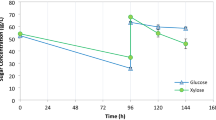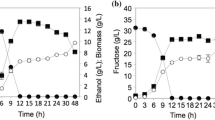Abstract
White-rot fungi are microorganisms capable of ethanol fermentation; however, the specific conditions activating ethanol fermentation are unclear in contrast to fermentation by yeasts. In this study, we investigated the conditions favoring ethanol fermentation by the white-rot fungus Phanerochaete sordida YK-624, which is able to produce ethanol from woody material. In aerobic stationary cultivation with various concentrations of glucose (0.8–33 g/l), the fungus produced ethanol in media containing an initial glucose concentration of 2.8 g/l or higher. The amount of glucose consumption, mycelial weight, and ethanol production on the second day of culture increased in a concentration-dependent manner at low glucose concentrations; however, these were saturated at high concentrations. Biomass yields (growth/glucose consumption) were decreased until the initial glucose concentration increased to 6.0 g/l, after which the biomass yields showed constant values at higher concentrations (12–33 g/l). On the other hand, ethanol yields increased with decreasing biomass yields. In short shaking cultivation using mycelial suspension, trace amounts of instantaneous aerobic ethanol production were observed with 1.1 and 2.1 g/l glucose, but the relative gene expression levels of key enzymes at the pyruvate branch point showed no significant differences between ethanol production and non-production conditions. From these experimental results, it appears that the white-rot fungus P. sordida YK-624 produces ethanol due to overflow in sugar metabolism under aerobic conditions, although P. sordida YK-624 prioritizes glucose utilization for respiratory growth.


Similar content being viewed by others
References
Bjurhager I, Olsson AM, Zhang B, Gerber L, Kumar M, Berglund LA, Burgert I, Sundberg B, Salmén L (2010) Ultrastructure and mechanical properties of populus wood with reduced lignin content caused by transgenic down-regulation of cinnamate 4-hydroxylase. Biomacromol 11:2359–2365. https://doi.org/10.1021/bm100487e
Dashko S, Zhou N, Compagno C, Piškur J (2014) Why, when, and how did yeast evolve alcoholic fermentation? FEMS Yeast Res 14:826–832. https://doi.org/10.1111/1567-1364.12161
Diaz-Ruiz R, Rigoulet M, Devin A (2011) The Warburg and Crabtree effects: on the origin of cancer cell energy metabolism and of yeast glucose repression. Biochim Biophys Acta 1807:568–576. https://doi.org/10.1016/j.bbabio.2010.08.010
Hagman A, Piškur J (2015) A study on the fundamental mechanism and the evolutionary driving forces behind aerobic fermentation in yeast. PLoS ONE 10:e0116942. https://doi.org/10.1371/journal.pone.0116942
Hagman A, Säll T, Piškur J (2014) Analysis of the yeast short-term Crabtree effect and its origin. FEBS J 281:4805–4814. https://doi.org/10.1111/febs.13019
Hirai H, Kondo R, Sakai K (1994) Screening of lignin-degrading fungi and their ligninolytic enzyme activities during biological bleaching of kraft pulp. Mokuzai Gakkaishi 40:980–986
Horisawa S, Ando H, Ariga O, Sakuma Y (2015) Direct ethanol production from cellulosic materials by consolidated biological processing using the wood rot fungus Schizophyllum commune. Bioresour Technol 197:37–41. https://doi.org/10.1016/j.biortech.2015.08.031
Kamei I, Hirota Y, Meguro S (2012) Integrated delignification and simultaneous saccharification and fermentation of hard wood by a white-rot fungus, Phlebia sp. MG-60. Bioresour Technol 126:137–141. https://doi.org/10.1016/j.biortech.2012.09.007
Kamei I, Hirota Y, Mori T, Hirai H, Meguro S, Kondo R (2012) Direct ethanol production from cellulosic materials by the hypersaline-tolerant white-rot fungus Phlebia sp. MG-60. Bioresour Technol 112:137–142. https://doi.org/10.1016/j.biortech.2012.02.109
Mattila H, Kuuskeri J, Lundell T (2017) Single-step, single-organism bioethanol production and bioconversion of lignocellulose waste materials by phlebioid fungal species. Bioresour Technol 225:254–261. https://doi.org/10.1016/j.biortech.2016.11.082
Mori T, Kako H, Sumiya T, Kawagishi H, Hirai H (2016) Direct lactic acid production from beech wood by transgenic white-rot fungus Phanerochaete sordida YK-624. J Biotechnol 239:83–89. https://doi.org/10.1016/j.jbiotec.2016.10.014
Okamoto K, Imashiro K, Akizawa Y, Onimura A, Yoneda M, Nitta Y, Maekawa N, Yanase H (2010) Production of ethanol by the white-rot basidiomycetes Peniophora cinerea and Trametes suaveolens. Biotechnol Lett 32:909–913. https://doi.org/10.1007/s10529-010-0243-7
Okamoto K, Kanawaku R, Masumoto M, Yanase H (2012) Efficient xylose fermentation by the brown rot fungus Neolentinus lepideus. Enzyme Microb Technol 50:96–100. https://doi.org/10.1016/j.enzmictec.2011.10.002
Okamoto K, Uchii A, Kanawaku R, Yanase H (2014) Bioconversion of xylose, hexoses and biomass to ethanol by a new isolate of the white rot basidiomycete Trametes versicolor. Springerplus 3:121. https://doi.org/10.1186/2193-1801-3-121
Postma E, Verduyn C, Scheffers WA, Van Dijken JP (1989) Enzymic analysis of the crabtree effect in glucose-limited chemostat cultures of Saccharomyces cerevisiae. Appl Environ Microbiol 55:468–477
Pronk JTJJT, Steensma HY, Van Dijken JP (1996) Pyruvate metabolism in Saccharomyces cerevisiae. Yeast 12:1607–1633 https://doi.org/10.1002/(SICI)1097-0061(199612)12:16%3C1607::AID-YEA70%3E3.0.CO;2-4
Ruiz-Dueñas FJ, Martínez ÁT (2009) Microbial degradation of lignin: how a bulky recalcitrant polymer is efficiently recycled in nature and how we can take advantage of this. Microb Biotechnol 2:164–177. https://doi.org/10.1111/j.1751-7915.2008.00078.x
Voelker SL, Lachenbruch B, Meinzer FC, Strauss SH (2011) Reduced wood stiffness and strength, and altered stem form, in young antisense 4CL transgenic poplars with reduced lignin contents. New Phytol 189:1096–1109. https://doi.org/10.1111/j.1469-8137.2010.03572.x
Wang J, Hirabayashi S, Mori T, Kawagishi H, Hirai H (2016) Improvement of ethanol production by recombinant expression of pyruvate decarboxylase in the white-rot fungus Phanerochaete sordida YK-624. J Biosci Bioeng 122:17–21. https://doi.org/10.1016/j.jbiosc.2015.12.002
Wang J, Suzuki T, Dohra H, Takigami S, Kako H, Soga A, Kamei I, Mori T, Kawagishi H, Hirai H (2016) Analysis of ethanol fermentation mechanism of ethanol producing white-rot fungus Phlebia sp. MG-60 by RNA-sEq. BMC Genomics 17:616. https://doi.org/10.1186/s12864-016-2977-7
Yamagishi K, Kimura T, Oita S, Sugiura T, Hirai H (2007) Transformation by complementation of a uracil auxotroph of the hyper lignin-degrading basidiomycete Phanerochaete sordida YK-624. Appl Microbiol Biotechnol 76:1079–1091. https://doi.org/10.1007/s00253-007-1093-7
Acknowledgements
This work was supported by a Grant-in-Aid for Scientific Research (C) (Grant No. 17K08167) from the Ministry of Education, Culture, Sports, Science and Technology of Japan.
Author information
Authors and Affiliations
Corresponding author
Ethics declarations
Conflict of interest
The authors declare that they have no conflict of interest.
Additional information
Publisher’s Note
Springer Nature remains neutral with regard to jurisdictional claims in published maps and institutional affiliations.
Electronic supplementary material
Below is the link to the electronic supplementary material.
Rights and permissions
About this article
Cite this article
Mori, T., Kondo, O., Kawagishi, H. et al. Effects of Glucose Concentration on Ethanol Fermentation of White-Rot Fungus Phanerochaete sordida YK-624 Under Aerobic Conditions. Curr Microbiol 76, 263–269 (2019). https://doi.org/10.1007/s00284-018-01622-3
Received:
Accepted:
Published:
Issue Date:
DOI: https://doi.org/10.1007/s00284-018-01622-3




